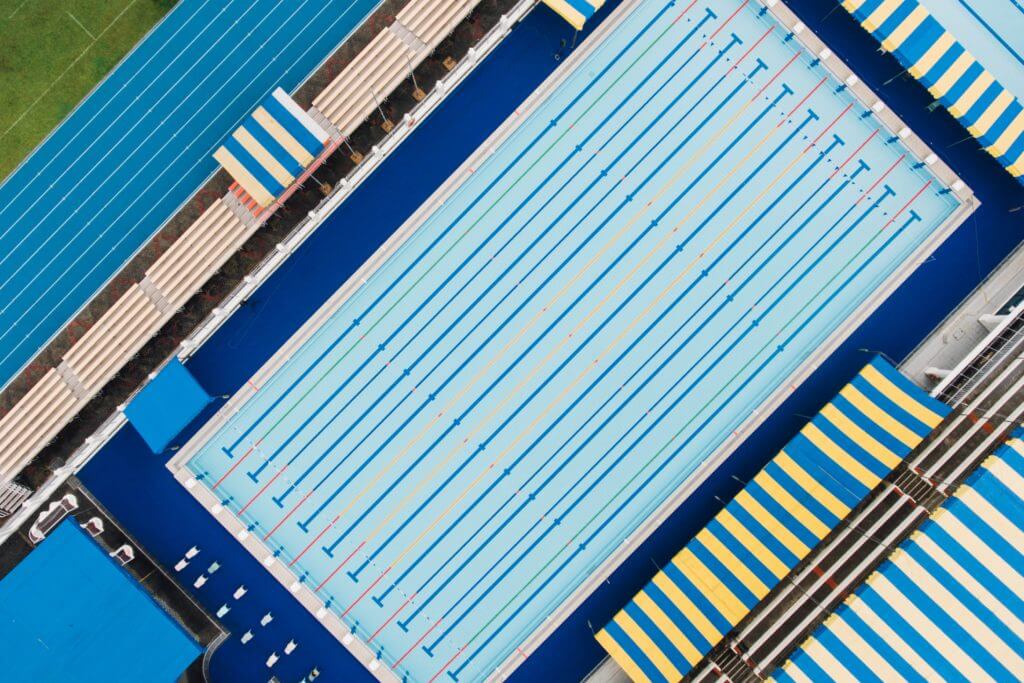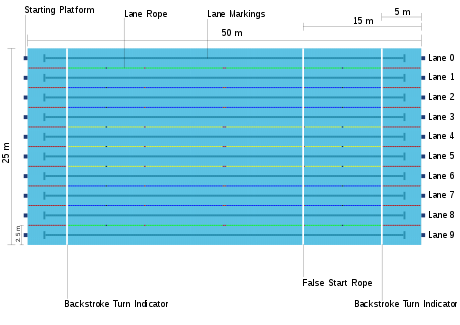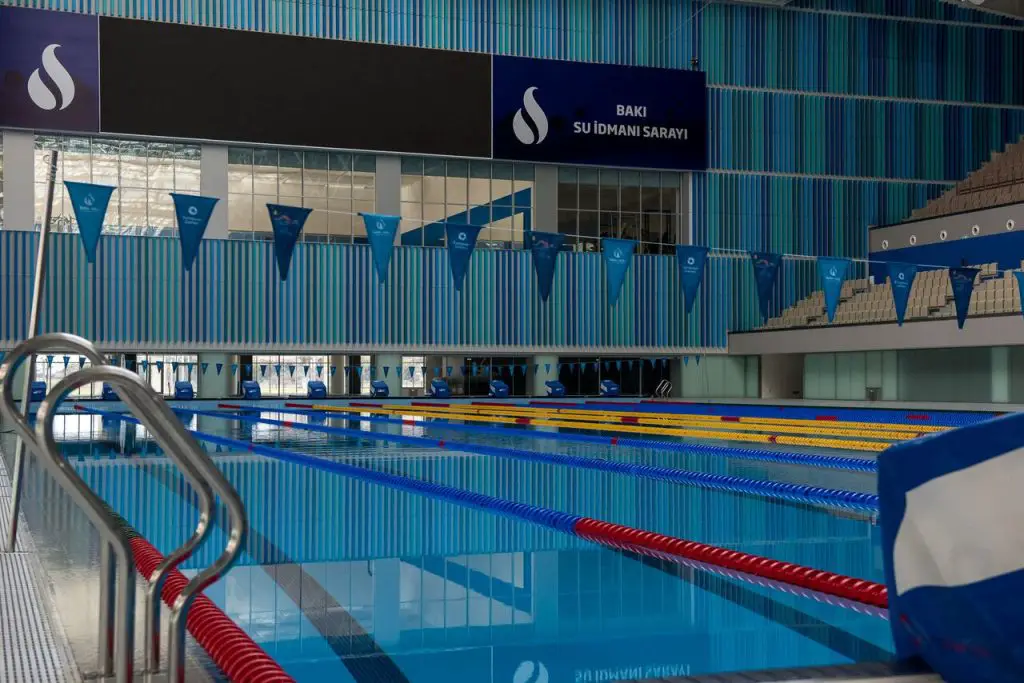An Olympic pool is typically 50 meters long. Olympic pools are 50 meters in length.
An Olympic pool is often referred to as a standard-sized swimming pool used in Olympic competitions. These pools have specific dimensions that adhere to international standards. One of the key measurements for an Olympic pool is its length, which is typically 50 meters.
This ensures that swimmers have enough space to showcase their skills and compete at the highest level. The length of the pool allows for long-distance races and proper separation between lanes. Additionally, Olympic pools also feature other important specifications such as the number of lanes, water depth, and temperature control to ensure fairness and safety during the competition. Understanding the dimensions of an Olympic pool helps to appreciate the immense effort and skill displayed by athletes participating in these prestigious events.

Credit: clearcomfort.com
The Olympic Pool Standard
Length Of An Olympic-sized Pool
An Olympic-sized pool has a length of 50 meters, which is equivalent to 164 feet.
Width And Depth Of The Pool
The width and depth of an Olympic-sized pool are 25 meters and 2 meters respectively. The width translates to around 82 feet.
Comparing To Regular Pools
When it comes to comparing an Olympic-size pool to regular ones, there are substantial differences to consider. The size difference with a standard pool and its impact on performance and training can greatly affect athletes and swimmers. Let’s delve into how these differences play a critical role in the world of competitive swimming.
Size Difference With A Standard Pool
An Olympic-size pool spans a length of 50 meters, while a standard pool typically measures 25 yards or 25 meters. The significant contrast in length can impact the speed and strategy of swimmers.
Impact On Performance And Training
The longer length of an Olympic-size pool affects swimmers’ stamina, endurance, and pacing. It demands a different approach to turning, pushing off the wall, and breathing rhythm. Athletes need to adapt their training techniques to account for the increased distance, which can enhance their overall performance in competition.
Evolution Of Olympic Pool Standards
The dimensions of Olympic swimming pools have undergone significant changes over the years, evolving to meet the needs of athletes and ensure fair competition. Historical changes in pool dimensions and the factors driving these changes have played a crucial role in shaping the standards we have today.
Historical Changes In Pool Dimensions
Through the decades, the International Olympic Committee (IOC) has adapted and revised the specifications for Olympic pools. These changes reflect a combination of technological advancements, research findings, and the desire to create the best possible conditions for athletes to achieve their peak performance.
In the early days, Olympic pools were typically 50 meters in length, conforming to traditional swimming pool standards. However, it wasn’t until the 1952 Helsinki Olympics that the official dimensions were officially established as 50 meters in length, 25 meters in width, and at least 2 meters in depth. This standardization aimed to ensure consistency and fairness in swimming competitions across different venues.
Factors Driving Changes
There are several factors that have driven the changes in Olympic pool dimensions over time. First and foremost is the desire to improve the performance of swimmers. As athletes continue to push the boundaries of what is physically possible, pool designers and officials must adapt to accommodate their evolving needs.
Advances in technology have also played a significant role in shaping pool standards. The introduction of more efficient pool filtration systems, improved starting blocks, and underwater cameras for monitoring races have led to changes in pool dimensions to incorporate these advancements.
Additionally, research and studies on hydrodynamics and fluid mechanics have prompted adjustments to pool dimensions. By fine-tuning the length, width, and depth of the pool, researchers aim to minimize the impact of waves and turbulence, allowing swimmers to move through the water with greater ease and efficiency.
Moreover, the increasing popularity and global reach of the Olympic Games have led to the construction of more swimming facilities around the world. This expansion has prompted the need for standardized pool dimensions that can be replicated in different locations, ensuring fair competition no matter where the games are held.
Construction Challenges
Engineering considerations for Olympic pools: When building Olympic-sized pools, structural integrity is crucial.
Maintenance demands of large pools: Ensuring proper upkeep is essential for optimal performance and longevity.
Engineering Considerations For Olympic Pools
Olympic pools require specific engineering to meet international standards.
- Proper depth and length are critical for competitive swimming events.
- High-quality materials are essential for durability and safety.
- Advanced filtration and circulation systems are necessary for water quality.
Maintenance Demands Of Large Pools
Large pools demand meticulous maintenance to ensure functionality and safety.
- Regular cleaning and water testing are vital to prevent contamination.
- Monitoring temperature and chemical levels is key to optimal performance.
- Professional servicing of equipment helps prevent breakdowns and malfunctions.
Global Variations
When it comes to Olympic pools, there are fascinating global variations in their sizes. Differences in pool sizes across countries not only reflect the unique preferences of each nation, but also have a significant influence on international competitions.
Differences In Pool Sizes Across Countries
Pool sizes can vary widely from one country to another. While the standard Olympic pool length is 50 meters, some countries have different sizes. For example, the United States commonly uses a 25-yard pool for swimming competitions, which is equivalent to approximately 23 meters. On the other hand, in some European countries like Russia, pools are often measured in 25-meter lengths. China, with its growing prominence in the world of swimming, also uses 25-meter pools for competitions.
In addition to length variations, the width of Olympic-sized pools can also differ between countries. The standard width is around 25 meters, but some countries, like Australia, favor wider pools, extending up to 30 meters. These variations in pool dimensions highlight the diverse approaches adopted by different nations, taking into account factors such as swimming technique, space availability, and cultural preferences.
Influence On International Competitions
The size of a pool can significantly influence international competitions, particularly in swimming. The varying pool dimensions impact race strategies, swimmer performance, and records achieved. Athletes accustomed to swimming in pools of a particular size may face challenges when competing in pools with different dimensions. For example, a swimmer who trains in a 25-yard pool may need to adjust their stroke rhythm and pacing when participating in a 50-meter pool, and vice versa. These adjustments can affect athletes’ overall performances, making competitions more dynamic and unpredictable.
Moreover, the influence of pool size extends beyond individual athletes to the overall dynamics of international competitions. Hosting swim meets and championships in pools with different dimensions brings diversity to the sport and ensures fairness. It also requires swimmers to adapt and evolve their techniques to maintain their competitive edge and achieve success on a global stage.
In conclusion, the global variations in Olympic pool sizes offer a fascinating insight into the diverse swimming culture around the world. While maintaining a standard length of 50 meters, countries vary in their preferred pool lengths and widths. These variations not only reflect unique national preferences but also have a tangible impact on international competitions, challenging athletes to adapt and excel in different pool dimensions.
Technological Innovations
The length of an Olympic pool plays a crucial role in determining the outcome of swimming competitions. Advancements in pool design and materials have greatly influenced the construction of Olympic-sized swimming pools.
Advancements In Pool Design And Materials
- Innovative pool designs enhance swimmer performance.
- Use of state-of-the-art materials improves durability and efficiency.
- Integration of cutting-edge technology ensures top-notch quality.
Impact On Speed And Safety
- Increased pool length enhances speed records in swimming events.
- Advanced materials contribute to the safety of swimmers.
Technological innovations have reshaped the landscape of Olympic pools, allowing for faster and safer competitions.
Famous Olympic Pool Locations
The Olympic Games have showcased some iconic venues that have hosted the swimming events, leaving remarkable impacts on the history of the games. Here are some famous Olympic pool locations that have played a crucial role in the legacy of Olympic swimming.
Iconic Venues Hosting Olympic Swimming Events
Below are some of the most iconic venues that have hosted Olympic swimming events:
| Location | Historical Significance |
|---|---|
| Rio de Janeiro, Brazil | Hosted the 2016 Summer Olympics, featuring the Olympic Aquatics Stadium which witnessed numerous world records being broken. |
| Los Angeles, USA | The Los Angeles Memorial Coliseum was the venue for the 1932 Summer Olympics, setting the stage for many historic moments in swimming. |
| Sydney, Australia | The Sydney International Aquatic Centre gained fame during the 2000 Summer Olympics as the site of the iconic competitions among world-class swimmers. |
Historical Significance Of These Locations
- Rio de Janeiro, Brazil: The Olympic Aquatics Stadium in Rio is revered for witnessing unparalleled achievements in swimming.
- Los Angeles, USA: The historic setting of the Los Angeles Memorial Coliseum brings nostalgia and remembrance of legendary swimming races.
- Sydney, Australia: The Sydney International Aquatic Centre holds significant historical value, being the stage for some of the most memorable swimming events.

Credit: en.wikipedia.org
Future Of Olympic Pool Design
An Olympic-size swimming pool has been the standard for competitive swimming since the 1950s. However, as technology and sustainability practices evolve, the future of Olympic pool design is poised for exciting changes. Advancements in engineering, materials, and eco-friendly construction are shaping the next generation of pools.
Trends Shaping The Next Generation Of Pools
- Integration of advanced filtration systems for improved water quality
- Utilization of state-of-the-art materials for enhanced durability and performance
- Incorporation of innovative design elements to elevate the overall swimming experience for athletes and spectators
Sustainability And Eco-friendly Practices In Pool Construction
- Adoption of energy-efficient heating and cooling systems to reduce environmental impact
- Implementation of water conservation measures through smart usage and recycling initiatives
- Embracing eco-friendly building materials and construction methods to minimize carbon footprint
:max_bytes(150000):strip_icc()/RioOlympicsswimmingpool-GettyImages-519838356-59c09963054ad90011cf5247.jpg)
Credit: www.liveabout.com
Conclusion
The standard Olympic pool length is 50 meters. Understanding this measurement helps swimmers and spectators appreciate the true scale of the competition. From its humble origins to the grand Olympic stage, the length of the pool holds significant importance in the world of swimming.





